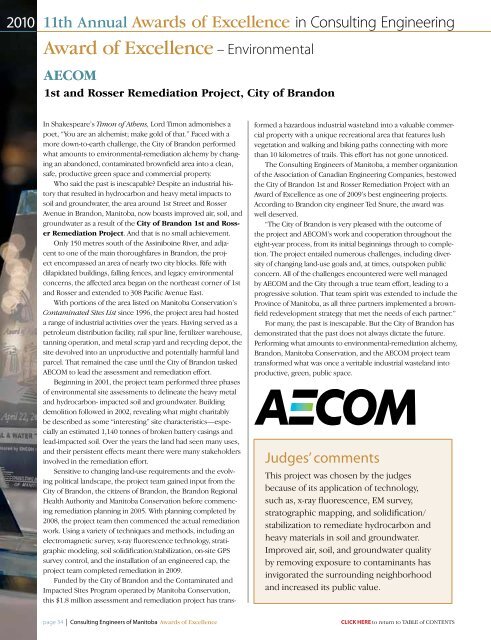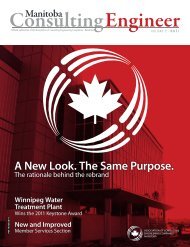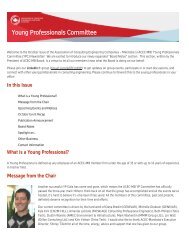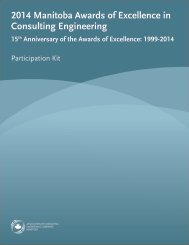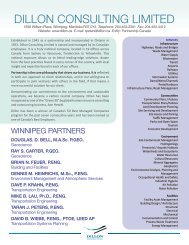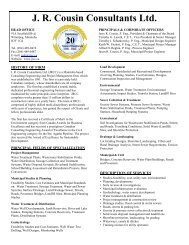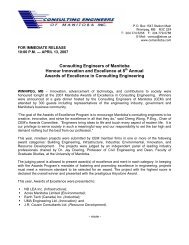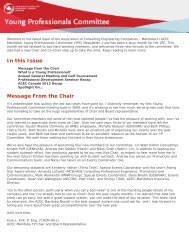Premiere Edition - ACEC|Manitoba
Premiere Edition - ACEC|Manitoba
Premiere Edition - ACEC|Manitoba
You also want an ePaper? Increase the reach of your titles
YUMPU automatically turns print PDFs into web optimized ePapers that Google loves.
2010 11th Annual Awards of Excellence in Consulting Engineering<br />
Award of Excellence – Environmental<br />
AECOM<br />
1st and Rosser Remediation Project, City of Brandon<br />
In Shakespeare’s Timon of Athens, Lord Timon admonishes a<br />
poet, “You are an alchemist; make gold of that.” Faced with a<br />
more down-to-earth challenge, the City of Brandon performed<br />
what amounts to environmental-remediation alchemy by changing<br />
an abandoned, contaminated brownfield area into a clean,<br />
safe, productive green space and commercial property.<br />
Who said the past is inescapable? Despite an industrial history<br />
that resulted in hydrocarbon and heavy metal impacts to<br />
soil and groundwater, the area around 1st Street and Rosser<br />
Avenue in Brandon, Manitoba, now boasts improved air, soil, and<br />
groundwater as a result of the City of Brandon 1st and Rosser<br />
Remediation Project. And that is no small achievement.<br />
Only 150 metres south of the Assiniboine River, and adjacent<br />
to one of the main thoroughfares in Brandon, the project<br />
encompassed an area of nearly two city blocks. Rife with<br />
dilapidated buildings, falling fences, and legacy environmental<br />
concerns, the affected area began on the northeast corner of 1st<br />
and Rosser and extended to 308 Pacific Avenue East.<br />
With portions of the area listed on Manitoba Conservation’s<br />
Contaminated Sites List since 1996, the project area had hosted<br />
a range of industrial activities over the years. Having served as a<br />
petroleum distribution facility, rail spur line, fertilizer warehouse,<br />
tanning operation, and metal scrap yard and recycling depot, the<br />
site devolved into an unproductive and potentially harmful land<br />
parcel. That remained the case until the City of Brandon tasked<br />
AECOM to lead the assessment and remediation effort.<br />
Beginning in 2001, the project team performed three phases<br />
of environmental site assessments to delineate the heavy metal<br />
and hydrocarbon- impacted soil and groundwater. Building<br />
demolition followed in 2002, revealing what might charitably<br />
be described as some “interesting” site characteristics—especially<br />
an estimated 1,140 tonnes of broken battery casings and<br />
lead-impacted soil. Over the years the land had seen many uses,<br />
and their persistent effects meant there were many stakeholders<br />
involved in the remediation effort.<br />
Sensitive to changing land-use requirements and the evolving<br />
political landscape, the project team gained input from the<br />
City of Brandon, the citizens of Brandon, the Brandon Regional<br />
Health Authority and Manitoba Conservation before commencing<br />
remediation planning in 2005. With planning completed by<br />
2008, the project team then commenced the actual remediation<br />
work. Using a variety of techniques and methods, including an<br />
electromagnetic survey, x-ray fluorescence technology, stratigraphic<br />
modeling, soil solidification/stabilization, on-site GPS<br />
survey control, and the installation of an engineered cap, the<br />
project team completed remediation in 2009.<br />
Funded by the City of Brandon and the Contaminated and<br />
Impacted Sites Program operated by Manitoba Conservation,<br />
this $1.8 million assessment and remediation project has trans-<br />
formed a hazardous industrial wasteland into a valuable commercial<br />
property with a unique recreational area that features lush<br />
vegetation and walking and biking paths connecting with more<br />
than 10 kilometres of trails. This effort has not gone unnoticed.<br />
The Consulting Engineers of Manitoba, a member organization<br />
of the Association of Canadian Engineering Companies, bestowed<br />
the City of Brandon 1st and Rosser Remediation Project with an<br />
Award of Excellence as one of 2009’s best engineering projects.<br />
According to Brandon city engineer Ted Snure, the award was<br />
well deserved.<br />
“The City of Brandon is very pleased with the outcome of<br />
the project and AECOM’s work and cooperation throughout the<br />
eight-year process, from its initial beginnings through to completion.<br />
The project entailed numerous challenges, including diversity<br />
of changing land-use goals and, at times, outspoken public<br />
concern. All of the challenges encountered were well managed<br />
by AECOM and the City through a true team effort, leading to a<br />
progressive solution. That team spirit was extended to include the<br />
Province of Manitoba, as all three partners implemented a brownfield<br />
redevelopment strategy that met the needs of each partner.”<br />
For many, the past is inescapable. But the City of Brandon has<br />
demonstrated that the past does not always dictate the future.<br />
Performing what amounts to environmental-remediation alchemy,<br />
Brandon, Manitoba Conservation, and the AECOM project team<br />
transformed what was once a veritable industrial wasteland into<br />
productive, green, public space.<br />
Judges’ comments<br />
This project was chosen by the judges<br />
because of its application of technology,<br />
such as, x-ray fluorescence, EM survey,<br />
stratographic mapping, and solidification/<br />
stabilization to remediate hydrocarbon and<br />
heavy materials in soil and groundwater.<br />
Improved air, soil, and groundwater quality<br />
by removing exposure to contaminants has<br />
invigorated the surrounding neighborhood<br />
and increased its public value.<br />
page 34 | Consulting Engineers of Manitoba Awards of Excellence<br />
Click Here to return to Table of Contents


